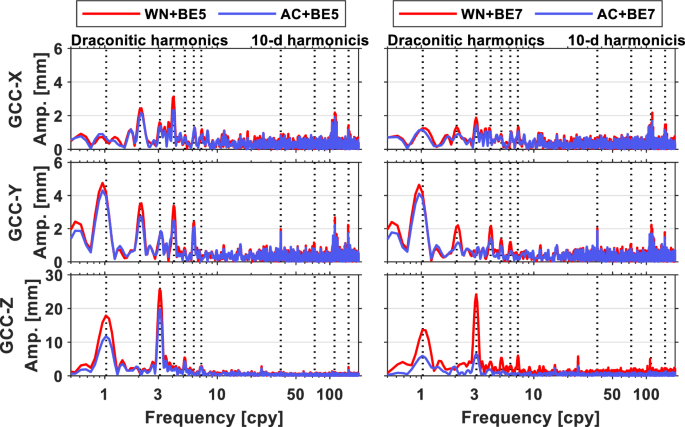Abstract
In the geocenter motion determination using the Global Navigation Satellite Systems (GNSS), satellite clock offsets are usually estimated as white noise process. The correlation between geocenter coordinates (GCC) and the epoch-wise satellite clocks brings inferior GCC estimates, especially for the Z component. In this contribution, satellite clock offsets are described by the polynomial model, and the deviation of the model from the truth is estimated as a random parameter whose process noise is described by the variogram. Based on 3.7 years of BDS, Galileo and GPS observations from 98 global stations, we investigate the impact of the atomic clock model on GCC estimates. After employing the proposed model, the formal errors of GCC-Z component are reduced by 23–46%, 15–31% and 3–9% for BDS, Galileo and GPS, respectively. When the 7-parameter extended empirical CODE orbit model with the a priori box-wing model (BE7) is used, the atomic clock model reduces the correlation of the B1C parameter and GCC-Z component by 0.28, 0.23 and 0.07 for BDS, Galileo and GPS, respectively. Besides, a mitigation of about 60% is obtained at the 3rd and 5th BDS draconitic harmonics and a mitigation of 55% at the 3rd Galileo draconitic harmonic for the GCC-Z component. The proposed model also contributes to reduce the annual amplitudes of single BDS, Galileo and GPS solutions, improving the agreement with the Satellite Laser Ranging solutions. As an additional verification, the resulting satellite orbits are also improved by satellite clock modeling. When the BE7 model is applied, the day boundary discontinuities of daily orbits are reduced by 3.4–3.6%, and the RMS of orbit differences relative to the ESA precise orbits is reduced by 8.2–8.5% for BDS and Galileo.

















Similar content being viewed by others
Data availability
The GNSS observations and precise satellite products used in this research are collected by IGS and ESA, which can be obtained at https://cddis.nasa.gov/ and http://navigation-office.esa.int/Products.html.
References
Allan DW (1987) Time and frequency (time-domain) characterization, estimation, and prediction of precision clocks and oscillators. IEEE Trans Ultrason Ferroelectr Freq Control 34(6):647–654. https://doi.org/10.1109/t-uffc.1987.26997
Altamimi Z, Rebischung P, Collilieux X, Métivier L, Chanard K (2023) ITRF2020: an augmented reference frame refining the modeling of nonlinear station motions. J Geodesy 97(5):47. https://doi.org/10.1007/s00190-023-01738-w
Arnold D, Meindl M, Beutler G, Dach R, Schaer S, Lutz S, Prange L, Sośnica K, Mervart L, Jäggi A (2015) CODE’s new solar radiation pressure model for GNSS orbit determination. J Geodesy 89(8):775–791. https://doi.org/10.1007/s00190-015-0814-4
Beckley BD, Lemoine FG, Luthcke SB, Ray RD, Zelensky NP (2007) A reassessment of global and regional mean sea level trends from TOPEX and Jason-1 altimetry based on revised reference frame and orbits. Geophys Res Lett. https://doi.org/10.1029/2007gl030002
Boehm J, Werl B, Schuh H (2006) Troposphere mapping functions for GPS and very long baseline interferometry from European Centre for Medium-Range Weather Forecasts operational analysis data. J Geophys Res Solid Earth 111(B02406):1–9. https://doi.org/10.1029/2005jb003629
Bury G, Zajdel R, Sośnica K (2019) Accounting for perturbing forces acting on Galileo using a box-wing model. GPS Solut. https://doi.org/10.1007/s10291-019-0860-0
Collilieux X, Altamimi Z, Ray J, van Dam T, Wu X (2009) Effect of the satellite laser ranging network distribution on geocenter motion estimation. J Geophys Res 114(B04402):1–17. https://doi.org/10.1029/2008jb005727
Cressie N, Hawkins DM (1980) Robust estimation of the variogram: I. J Int Assoc Math Geol 12(2):115–125
Crétaux J-F, Soudarin L, Davidson FJM, Gennero M-C, Bergé-Nguyen M, Cazenave A (2002) Seasonal and interannual geocenter motion from SLR and DORIS measurements: comparison with surface loading data. J Geophys Res Solid Earth 107(B12):2374. https://doi.org/10.1029/2002jb001820
CSNO (2019) Satellite Information of BDS. http://en.beidou.gov.cn/SYSTEMS/Officialdocument/201912/P020200323536298695483.zip
Dilssner F, Springer T, Enderle W (2011) GPS IIF yaw attitude control during eclipse season. In: AGU fall meeting, San Francisco, 2011
Dilssner F, Laufer G, Springer T, Schönemann E, Enderle W (2018) The BeiDou attitude model for continuous yawing MEO and IGSO spacecraft. In: EGU 2018, Vienna, 2018
Dong D, Yunck T, Heflin M (2003) Origin of the international terrestrial reference frame. J Geophys Res 108(B4):1–10. https://doi.org/10.1029/2002jb002035
Geng T, Jiang R, Lv Y, Xie X (2022) Analysis of BDS-3 onboard clocks based on GFZ precise clock products. Remote Sens 14(6):1389. https://doi.org/10.3390/rs14061389
Gross R, Beutler G, Plag H-P (2009) Integrated scientific and societal user requirements and functional specifications for the GGOS. In: Plag H-P, Pearlman M (eds) Global geodetic observing system. Springer, Berlin. https://doi.org/10.1007/978-3-642-02687-4
Gu S, Mao F, Gong X, Lou Y, Xu X, Zhou Y (2021) Evaluation of BDS-2 and BDS-3 satellite atomic clock products and their effects on positioning. Remote Sens 13(24):5041. https://doi.org/10.3390/rs13245041
Gu SF, Mao FY, Gong XP, Lou YD, Shi C (2023) Improved short-term stability for real-time GNSS satellite clock estimation with clock model. J Geodesy. https://doi.org/10.1007/s00190-023-01747-9
Hackel S, Steigenberger P, Hugentobler U, Uhlemann M, Montenbruck O (2014) Galileo orbit determination using combined GNSS and SLR observations. GPS Solut 19(1):15–25. https://doi.org/10.1007/s10291-013-0361-5
Hernández-Pajares M, Juan JM, Sanz J, Orús R (2007) Second-order ionospheric term in GPS: implementation and impact on geodetic estimates. J Geophys Res. https://doi.org/10.1029/2006jb004707
Kazmierski K, Sośnica K, Hadas T (2017) Quality assessment of multi-GNSS orbits and clocks for real-time precise point positioning. GPS Solut. https://doi.org/10.1007/s10291-017-0678-6
König R, Reigber C, Zhu SY (2005) Dynamic model orbits and Earth system parameters from combined GPS and LEO data. Adv Space Res 36(3):431–437. https://doi.org/10.1016/j.asr.2005.03.064
Kouba J (2008) A simplified yaw-attitude model for eclipsing GPS satellites. GPS Solut 13(1):1–12. https://doi.org/10.1007/s10291-008-0092-1
Kuang D, Schutz BE, Watkins MM (1996) On the structure of geometric positioning information in GPS measurements. J Geodesy 71(1):35–43. https://doi.org/10.1007/s001900050073
Kuang D, Bar-Sever Y, Haines B (2015) Analysis of orbital configurations for geocenter determination with GPS and low-Earth orbiters. J Geodesy 89(5):471–481. https://doi.org/10.1007/s00190-015-0792-6
Kuang D, Bertiger W, Desai SD, Haines BJ, Yuan D-N (2019) Observed geocenter motion from precise orbit determination of GRACE satellites using GPS tracking and accelerometer data. J Geodesy 93(10):1835–1844. https://doi.org/10.1007/s00190-019-01283-5
Lagler K, Schindelegger M, Bohm J, Krasna H, Nilsson T (2013) GPT2: empirical slant delay model for radio space geodetic techniques. Geophys Res Lett 40(6):1069–1073. https://doi.org/10.1002/grl.50288
Li X, Pan L (2021) Precise point positioning with almost fully deployed BDS-3, BDS-2, GPS, GLONASS, Galileo and QZSS using precise products from different analysis centers. Remote Sens 13(19):3905. https://doi.org/10.3390/rs13193905
Li X, Huang S, Yuan Y, Zhang K, Lou J (2023) Geocenter motions derived from BDS observations: effects of the solar radiation pressure model and constellation configuration. Remote Sens 15(5):1243. https://doi.org/10.3390/rs15051243
Männel B, Rothacher M (2017) Geocenter variations derived from a combined processing of LEO- and ground-based GPS observations. J Geodesy 91(8):933–944. https://doi.org/10.1007/s00190-017-0997-y
Matheron G (1963) Principles of geostatistics. Econ Geol 58(8):1246–1266. https://doi.org/10.2113/gsecongeo.58.8.1246
Meindl M, Beutler G, Thaller D, Dach R, Jäggi A (2013) Geocenter coordinates estimated from GNSS data as viewed by perturbation theory. Adv Space Res 51(7):1047–1064. https://doi.org/10.1016/j.asr.2012.10.026
Montenbruck O, Schmid R, Mercier F, Steigenberger P, Noll C, Fatkulin R, Kogure S, Ganeshan AS (2015) GNSS satellite geometry and attitude models. Adv Space Res 56(6):1015–1029. https://doi.org/10.1016/j.asr.2015.06.019
Moore P, Wang J (2003) Geocentre variation from laser tracking of LAGEOS1/2 and loading data. Integr Space Geod Syst Satell Dyn 31(8):1927–1933. https://doi.org/10.1016/S0273-1177(03)00170-4
Peng Y, Lou Y, Gong X, Wang Y, Dai X (2019) Real-time clock prediction of multi-GNSS satellites and its application in precise point positioning. Adv Space Res 64(7):1445–1454. https://doi.org/10.1016/j.asr.2019.06.040
Peng Y, Lou Y, Dai X, Guo J, Shi C (2022) Impact of solar radiation pressure models on earth rotation parameters derived from BDS. GPS Solut. https://doi.org/10.1007/s10291-022-01316-1
Petit G, Luzum B (2010) IERS Conventions (2010). IERS technical note, vol 36. Verlag des Bundesamts für Kartographie und Geodäsie, Frankfurt am Main, Germany
Qing Y, Lou Y, Dai X, Liu Y (2017) Benefits of satellite clock modeling in BDS and Galileo orbit determination. Adv Space Res 60(12):2550–2560. https://doi.org/10.1016/j.asr.2017.03.040
Ray J, Altamimi Z, Collilieux X, van Dam T (2007) Anomalous harmonics in the spectra of GPS position estimates. GPS Solut 12(1):55–64. https://doi.org/10.1007/s10291-007-0067-7
Rebischung P, Altamimi Z, Springer T (2013) A collinearity diagnosis of the GNSS geocenter determination. J Geodesy 88(1):65–85. https://doi.org/10.1007/s00190-013-0669-5
Rebischung P, Schmid R (2016) IGS14/igs14.atx: a new Framework for the IGS Products. Paper presented at the AGU Fall Meeting, San Francisco, CA, December 2016
Rebischung P, Villiger A, Masoumi S, Herring T (2022) [IGSMAIL-8238] Upcoming switch to IGS20/igs20.atx and repro3 standards. https://lists.igs.org/pipermail/igsmail/2022/008234.html
Ries JC (2016) Reconciling estimates of annual geocenter motion from space geodesy. In: The 20th international workshop on laser ranging, Potsdam, Germany, Potsdam, Germany 2016
Riley WJ (2013) Outliers in time and frequency measurements. Hamilton Technical Services
Rodriguez-Solano CJ, Hugentobler U, Steigenberger P, Lutz S (2011) Impact of Earth radiation pressure on GPS position estimates. J Geodesy 86(5):309–317. https://doi.org/10.1007/s00190-011-0517-4
Rodriguez-Solano CJ, Hugentobler U, Steigenberger P, Bloßfeld M, Fritsche M (2014) Reducing the draconitic errors in GNSS geodetic products. J Geodesy 88(6):559–574. https://doi.org/10.1007/s00190-014-0704-1
Saastamoinen J (1972) Contributions to the theory of atmospheric refraction. Bull Géodésique 105(1):279–298. https://doi.org/10.1007/BF02521844
Scaramuzza S, Dach R, Beutler G, Arnold D, Sušnik A, Jäggi A (2017) Dependency of geodynamic parameters on the GNSS constellation. J Geodesy 92(1):93–104. https://doi.org/10.1007/s00190-017-1047-5
Senior KL, Ray JR, Beard RL (2008) Characterization of periodic variations in the GPS satellite clocks. GPS Solut 12(3):211–225. https://doi.org/10.1007/s10291-008-0089-9
Shi C, Guo S, Gu S, Yang X, Gong X, Deng Z, Ge M, Schuh H (2018) Multi-GNSS satellite clock estimation constrained with oscillator noise model in the existence of data discontinuity. J Geodesy 93(4):515–528. https://doi.org/10.1007/s00190-018-1178-3
Shi C, Guo S, Fan L, Gu S, Fang X, Zhou L, Zhang T, Li Z, Li M, Li W, Wang C, Lou Y (2023) GSTAR: an innovative software platform for processing space geodetic data at the observation level. Satell Navig. https://doi.org/10.1186/s43020-023-00109-2
Shmaliy Y, Marienko A, Savchuk A (1999) GPS-Based Optimal Kalman Estimation of Time Error, Frequency Offset, and Aging. In: The 31th annual precise time and time interval systems and applications meeting, dana point, California, December 7 - 9 1999
Sośnica K, Zajdel R, Bury G, Bosy J, Moore M, Masoumi S (2020) Quality assessment of experimental IGS multi-GNSS combined orbits. GPS Solut. https://doi.org/10.1007/s10291-020-0965-5
Steigenberger P, Thoelert S, Montenbruck O (2020) GPS III Vespucci: results of half a year in orbit. Adv Space Res 66(12):2773–2785. https://doi.org/10.1016/j.asr.2020.03.026
Stewart MP, Penna NT, Lichti DD (2005) Investigating the propagation mechanism of unmodelled systematic errors on coordinate time series estimated using least squares. J Geodesy 79(8):479–489. https://doi.org/10.1007/s00190-005-0478-6
Vigue Y, Lichten SM, Blewitt G, Heflin MB, Malla RP (1992) Precise determination of Earth’s center of mass using measurements from the global positioning system. Geophys Res Lett 19(14):1487–1490. https://doi.org/10.1029/92GL01575
Wang N, Yuan Y, Li Z, Montenbruck O, Tan B (2015) Determination of differential code biases with multi-GNSS observations. J Geodesy 90(3):209–228. https://doi.org/10.1007/s00190-015-0867-4
Wu XP, Ray J, van Dam T (2012) Geocenter motion and its geodetic and geophysical implications. J Geodyn 58:44–61. https://doi.org/10.1016/j.jog.2012.01.007
Zajdel R, Sośnica K, Dach R, Bury G, Prange L, Jäggi A (2019) Network effects and handling of the geocenter motion in multi-GNSS processing. J Geophys Res Solid Earth 124(6):5970–5989. https://doi.org/10.1029/2019jb017443
Zajdel R, Sośnica K, Bury G, Dach R, Prange L (2020) System-specific systematic errors in earth rotation parameters derived from GPS, GLONASS, and Galileo. GPS Solut. https://doi.org/10.1007/s10291-020-00989-w
Zajdel R, Sośnica K, Bury G (2021) Geocenter coordinates derived from multi-GNSS: a look into the role of solar radiation pressure modeling. GPS Solut. https://doi.org/10.1007/s10291-020-01037-3
Zajdel R, Steigenberger P, Montenbruck O (2022) On the potential contribution of BeiDou-3 to the realization of the terrestrial reference frame scale. GPS Solut. https://doi.org/10.1007/s10291-022-01298-0
Zhang K, Li X, Jiang W, Fu Y, Yuan Y, Lou J, Zhang W (2023) Geocenter motion derived from multi-LEO precise orbit determination based on GNSS observations and dynamic force models. GPS Solut. https://doi.org/10.1007/s10291-023-01546-x
Zhao Q, Guo J, Wang C, Lyu Y, Xu X, Yang C, Li J (2022) Precise orbit determination for BDS satellites. Satellite Navig 3(1):1. https://doi.org/10.1186/s43020-021-00062-y
Acknowledgements
This study is supported by the National Key Research and Development Program of China (2023YFB3907304) and the National Natural Science Foundation of China (41931075, 42274041, 42174028). Thanks go to anonymous reviewers for their valuable comments and all authors are grateful to IGS for providing multi-GNSS data.
Author information
Authors and Affiliations
Contributions
S. Guo and L. Fan designed this research and prepared the manuscript; S. Guo conducted data processing; L. Fan and N. Wei helped to analyze results; S. Gu and X. Fang helped to develop the GSTAR software; all authors provided critical feedback and reviewed the paper.
Corresponding author
Appendix
Appendix
Rights and permissions
Springer Nature or its licensor (e.g. a society or other partner) holds exclusive rights to this article under a publishing agreement with the author(s) or other rightsholder(s); author self-archiving of the accepted manuscript version of this article is solely governed by the terms of such publishing agreement and applicable law.
About this article
Cite this article
Guo, S., Fan, L., Wei, N. et al. Impact of satellite clock modeling on the GNSS-based geocenter motion determination. J Geod 98, 70 (2024). https://doi.org/10.1007/s00190-024-01879-6
Received:
Accepted:
Published:
DOI: https://doi.org/10.1007/s00190-024-01879-6





